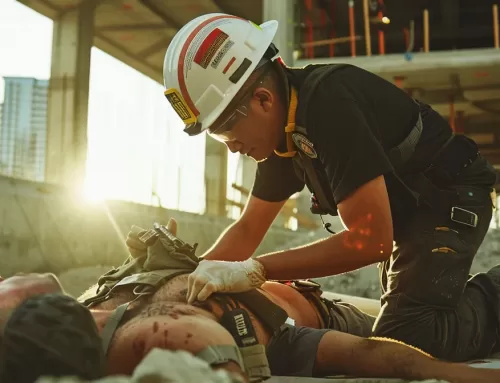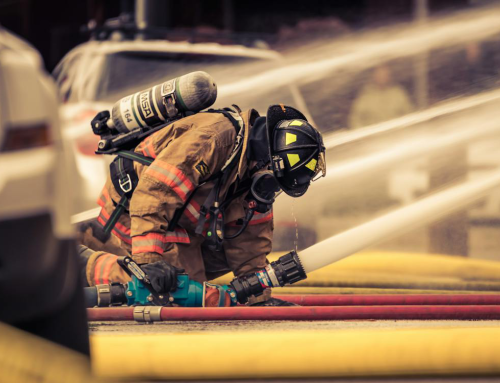The fast-paced environment today leaves no room for error – especially when it comes to your employees’ safety. Emergencies can strike without warning, and having a well-prepared workforce equipped with advanced first aid skills can make all the difference.
Occupational First Aid (OFA) Level 3 training represents the pinnacle of workplace first aid training in Canada, offering comprehensive modules designed to handle complex medical emergencies.
Continue reading this blog to explore the intricacies of Occupational First Aid Level 3 modules, their importance, the duration of the training, and a closer look at how this training is implemented in British Columbia (BC).
Understanding Advanced Level 3 First-Aid
Occupational First Aid Level 3 (OFA Level 3) is a highly specialized training program aimed at equipping individuals with the skills necessary to respond to a wide range of medical emergencies in the workplace.
Unlike basic first aid courses, which cover fundamental procedures, OFA Level 3 trains you for more advanced techniques and scenarios, ensuring that first aid attendants are prepared for the worst-case situations.
Core Modules Covered in OFA Level 3
1. Advanced Patient Assessment
- Detailed patient assessment techniques, including primary and secondary surveys.
- Understanding vital signs and how to monitor and interpret them.
- Techniques for assessing head, neck, and spinal injuries, as well as recognizing signs of serious internal injuries.
2. Priority Action Approach
- Understanding the Priority Action Approach to manage multiple casualties in emergency situations.
- Techniques for rapid assessment and prioritization of care based on the severity of injuries.
- Strategies for organizing and directing first aid efforts effectively in chaotic environments.
3. Airway Management and Oxygen Therapy
- Advanced methods for ensuring airway patency, including the use of oropharyngealand nasopharyngeal airways.
- Administering oxygen and understanding different oxygen delivery systems.
- Techniques for managing choking and ensuring adequate ventilation.
4. Cardiopulmonary Resuscitation (CPR) and Automated External Defibrillator (AED)
- High-quality CPR techniques for adults, children, and infants.
- Proper use of AEDs in emergency situations, including troubleshooting and maintenance.
- Advanced resuscitation techniques, including the use of bag-valve-mask (BVM) resuscitators.
5. Trauma Management
- Comprehensive strategies for managing traumatic injuries, such as fractures, dislocations, and severe bleeding.
- Use of splints, traction devices, and bandaging techniques for different types of injuries.
- Techniques for managing shock and preventing further injury.
6. Medical Emergencies
- Recognizing and responding to various medical emergencies, such as heart attacks, strokes, diabetic emergencies, and seizures.
- Administration of medications commonly used in first aid scenarios, including epinephrine auto-injectors for anaphylaxis.
- Strategies for dealing with poisoning and overdose situations.
7. Environmental Emergencies
- Handling emergencies related to environmental factors, such as hypothermia, heat stroke, and dehydration.
- Techniques for managing bites, stings, and allergic reactions.
- Understanding the implications of prolonged exposure to the elements and appropriate first aid measures.
8. Transportation of the Injured
- Safe and effective techniques for moving injured individuals, including the use of stretchers and spinal immobilization devices.
- Understanding the principles of safe lifting and transferring to prevent further injury.
- Coordination with emergency medical services (EMS) for efficient transport.
9. Eye Injuries
- Identifying and managing different types of eye injuries, such as foreign objects, chemical exposure, and trauma.
- Techniques for irrigating eyes and using protective coverings to prevent further damage.
- Understanding when to seek further medical assistance for severe eye injuries.
10. Upper Limb Fractures/Dislocations
- Methods for recognizing and treating fractures and dislocations of the upper limbs.
- Use of slings and other immobilization devices to support and protect injured limbs.
- Techniques for reducing pain and preventing further injury until professional medical help is available.
11. Hard Collar Application
- Proper application of hard collars to stabilize the cervical spine in cases of suspected neck injury.
- Techniques for ensuring correct fit and positioning to prevent further spinal damage.
- Coordination with EMS for safe transport of patients with potential spinal injuries.
Importance of OFA Level 3 Training
The comprehensive nature of OFA Level 3 training ensures that individuals are well-prepared to handle a wide array of emergencies, making workplaces safer.
Employers benefit from having trained personnel who can provide immediate and effective first aid, potentially saving lives and reducing the severity of injuries.
Additionally, workers feel more confident and secure knowing that their colleagues are equipped to handle emergencies proficiently.
Breakdown of the Training Schedule
Typically, an OFA level 3 course training schedule looks like this:
Pre-Course Study
- Participants often receive study materials before the course begins to familiarize themselves with the basic concepts and terminology.
Classroom Instruction
- The bulk of the training is conducted in a classroom setting, where participants engage in theoretical learning and practical demonstrations.
- Instructors use a variety of teaching methods, including lectures, multimedia presentations, and hands-on practice with medical equipment.
Practical Skills Sessions
- Practical sessions are an integral part of the training, allowing participants to practice and refine their skills.
- Role-playing scenarios and simulated emergencies help reinforce learning and build confidence.
Examinations and Assessments
- The course concludes with written and practical examinations to assess participants’ knowledge and skills.
- Successful completion of these assessments is necessary to receive certification.
Certification and Recertification
Upon successful completion of the OFA Level 3 course, participants receive a certification that is valid for three years. Given the advanced nature of the training, recertification involves completing a shorter refresher course to ensure that skills and knowledge remain current and effective.
Occupational First Aid Level 3 in BC
British Columbia (BC) is one of the provinces in Canada where Occupational First Aid Level 3 training is highly emphasized, particularly in industries such as construction, forestry, and mining, where workplace hazards are prevalent.
The province’s regulatory body, WorkSafeBC, sets stringent standards for first aid training to ensure the safety of workers.
WorkSafeBC Standards
WorkSafeBC outlines specific requirements for first aid attendants, including the necessity for OFA Level 3 certification in high-risk workplaces. The standards cover various aspects, including:
- First Aid Attendant Requirements:Depending on the number of workers and the nature of the work, different levels of first aid attendants are required. For higher-risk workplaces, having a Level 3 attendant is often mandatory.
- Equipment and Facilities:WorkSafeBC mandates that workplaces have appropriate first aid equipment and facilities, which first aid attendants must be familiar with and able to use effectively.
- Ongoing Training and Evaluation: Continuous training and evaluation are crucial to maintaining high standards. Employers are encouraged to provide regular training sessions and drills to ensure that skills remain sharp.
Training Providers in BC
Numerous accredited training providers in BC offer OFA Level 3 courses. These providers adhere to the guidelines set forth by WorkSafeBC, ensuring that the training meets provincial standards. Some of the prominent training providers include:
Metro Safety Training: Known for our comprehensive first aid training programs, Metro Safety Training offers OFA Level 3 courses that cover all essential modules.
Red Cross: The Red Cross provides a variety of first aid courses, including OFA Level 3, focusing on both theoretical knowledge and practical skills.
Local Colleges and Technical Institutes: Many colleges and technical institutes in BC offer Occupational First Aid training as part of their continuing education programs, making it accessible to a broader audience.
Benefits for Employers and Employees
Employers in BC who invest in OFA Level 3 training for their staff can expect numerous benefits, including:
- Enhanced Workplace Safety:With trained first aid attendants, the overall safety and preparedness of the workplace improve significantly.
- Compliance with Regulations:Adhering to WorkSafeBC standards ensures that employers are compliant with provincial regulations, avoiding potential fines and legal issues.
- Increased Employee Morale:Knowing that their safety is a priority can boost employee morale and productivity, creating a more positive work environment.
Real-Life Impact
A Saskatchewan Workers’ Compensation Board report noted a sharp decrease (12.75%) in time lost due to injuries in 2023 compared to 2022. They also found that 2023 was consecutively the fourth year where 90% of the province’s workplaces reported zero injuries or fatalities.
This is because more workers were trained to offer emergency first-aid to their colleagues. The advanced skills acquired through OFA level 3 training enable attendants to make critical decisions swiftly, demonstrating the importance of comprehensive first aid education.
Partner With Metro Safety Training to Elevate Your Safety Efforts in BC
If you’re looking to get theoretical and hands-on OFA level 3 training in BC, consider getting in touch with Metro Safety Training.
Our comprehensive program ensures that you or your employees are fully equipped to handle a wide array of workplace emergencies, enhancing overall safety and preparedness.
Our training has been shown to reduce injury claims and work time loss significantly, as both first aid attendants and their colleagues are better prepared to manage emergencies. This leads to a safer work environment and a more confident workforce.
So, contact us now and get started on your journey toward a safer, more resilient workplace in British Columbia!











